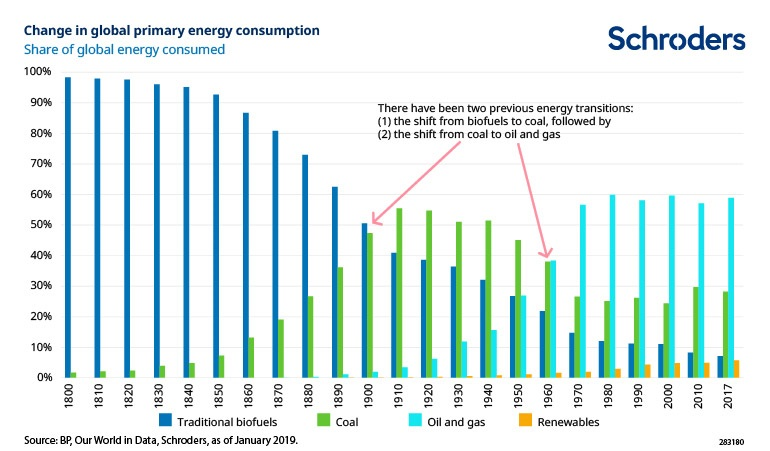
Energy Transition: What Does It Really Mean?
“People do not consume energy, rather an energy services; therefore, any energy source can be adopted if it provides the same level of energy service and meets the economic, social and environmental demands of people”.
This is the whole foundation upon which the probably worrying, maybe intimidating, but definitely, opportunity-filled ‘Energy Transition’ trend stands.
Usually, the energy transition has just been seen as a response to the depletion of a particular energy source, which compels people to adopt an alternative energy source, as was the case with whale oil and firewood in the 1800s. Per contra in the case of oil and gas substituting coal for electricity generation –among other things– the ease of adoption of the newer energy source or fuel –oil and gas in this case–, its efficiency, and cleaner nature trumped the availability and affordability of coal as the determining factor for transition. Hence, even though coal was available and more affordable, people’s desire became the greater determinant of their energy source choice.
The current transition from the still very available and more economic oil and gas to renewable energy is even more influenced by people’s desire for energy that is produced and used in such a way that their ability and that of their future generation to enjoy the benefits of energy services, is not jeopardized in all its social, economic, and environmental dimensions, than any other energy transition before. As a result, currently adopted energy sources are being scrutinized based on their carbon emission to meet the demand of the 2015 Paris Agreement and calls for environmental responsibility. As depicted in the illustration below world energy consumption – that is the demand side of the energy industry – has been gradually edging towards renewable options over their oil and gas counterparts, all based on people’s desire to have more sustainable energy options.

Energy Transition: Beyond Electric Power Generation
Even though arguably most people want to stop breathing in air that is polluted by conventional fossil fuel wastes, wind, solar and other forms of renewable energy, combined together, coupled with increased efficiency and enough amounts storage, will not provide enough power yet. The move to cleaner renewable energy sources will still be a gradual transition process as current consumption trends show, but pregnant with long-term investment and earning opportunities along its value chain. If a smart investor considers the supposed challenges, associated with the energy transition, he can immediately see the numerous opportunities hidden therein.
There are numerous national and international government funding and policies to enable investments in the diverse arms of the energy transition, particularly renewable energy generation, making it perhaps one of the best investment options for the energy transition.
In some countries, the cost of electricity from renewable sources like solar energy is approximately equivalent, probably cheaper than energy from the grid. This reduced cost coupled with consumers’ desire for environmentally friendly energy will see to the growth of power generation from renewable energy, and hence renewable energy jobs.
As earlier stated, renewable energy generation is just one part of the very many opportunities the energy transition brings with it. Other opportunities include the development of energy storage systems, industrial electrification, smart grid creation through the reengineering of current grid infrastructures, energy efficiency improvement of energy-consuming devices –including vehicles, phones, home appliances, etc.– to meet the available power from renewables, to mention a few. For example, the transmission of power generated from renewable projects to the grid and further distribution to individuals is set to create a ripple effect which will result in the demand for more electrical cables and power equipment, creating jobs for electricians, and electrical engineers.
The best part of the unconventional job opportunities is that there are no experts in the field. What will happen is that technicians, electricians, mechanics, engineers, chemists, biologists, etc. from onshore and offshore oil and gas jobs, manufacturing, power generation, transmission and distribution, researchers in and out of the energy industry will all have to go through a process of reskilling, and start developing the required knowledge as on the job labor before the skills can ever get to the classrooms or training grounds.
One set of otherwise unlikely people that are set to benefit monetarily from this new energy framework is the consumers. In Germany for example, a consumer’s excess energy can be sold to the grid. This is perceived to become the norm, as consumers who have their own renewable energy generation facility sell their excess energy to the central or a decentralized grid. This trend of decentralization of the energy system is yet another investment opportunity, with microgrids springing up as a response to the lack of proximity between the point of renewable energy generation and its use, which would create jobs for solar panels installers at the least.
As in the transmission and distribution sector where renewables are not always produced where they are needed, they are also not always produced when they are needed, creating an opportunity for battery operators, as well as battery manufacturers, and researchers that develop and enhance batteries that can provide storage solutions which will ensure electricity is available whenever it is needed.
There are massive opportunities for renewable energy jobs for companies and workers already in electric power generation, as well as manufacturing companies that produce solar panels and wind turbines. There are also massive investment and job opportunities in hydrogen for energy generation, in fact, hydrogen is estimated to phase out natural gas without the associated carbon dioxide (CO2) emissions, and can replace oil, gas, and natural gas in the non-power sector. The greatest opportunity now is in improving the efficiency of hydrogen by reducing its cost of production.
To conclude, the ongoing energy transition from fossil fuels to clean and renewable energy sources involves multiple players from policymakers to producers to consumers. The world energy system which has gone through many changes over time will again require new technology, new skills or reskilling of labor, new systems, new methodologies, and many more new or redesigned instruments for its development. All of these will inevitably require investments in equipment as well as in developing skilled labor in the emerging sector, to ensure the transition sustainably materializes.
Whether we are excited about it or not, the energy transition is our future as a race, and as Mark Twain rightly said, we must "Plan for the future, cause that’s where we are going to spend the rest of our lives". Therefore, let us begin the move.
Want to read more of this? Sign up for our newsletter. We publish regular articles on the energy sector.
__________________________________________________________________________________________________________________________________________________________________
About the Author
Tomisin is a Business Operations Specialist at Manup. She is an Industrial Chemist and Data Scientist with a Masters' degree in Energy and Environment, and a strong affinity for Sustainable Development.
The change you seek begins with you!